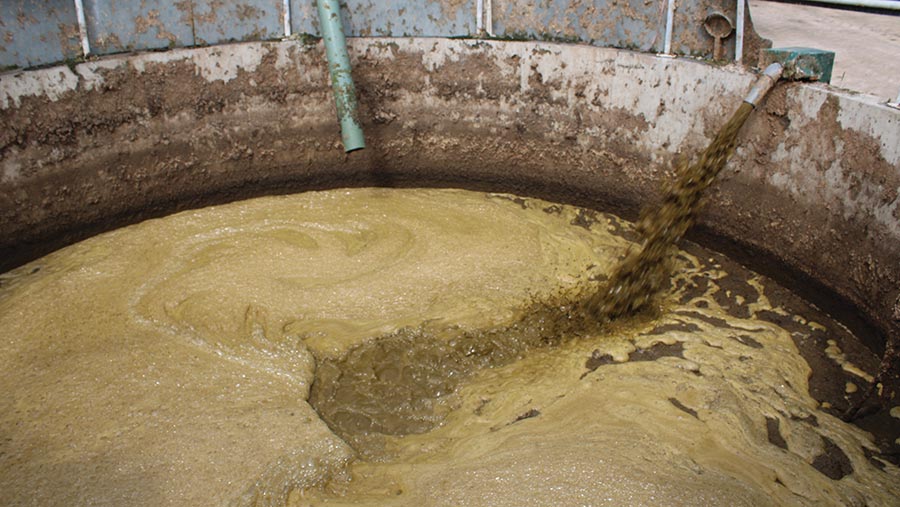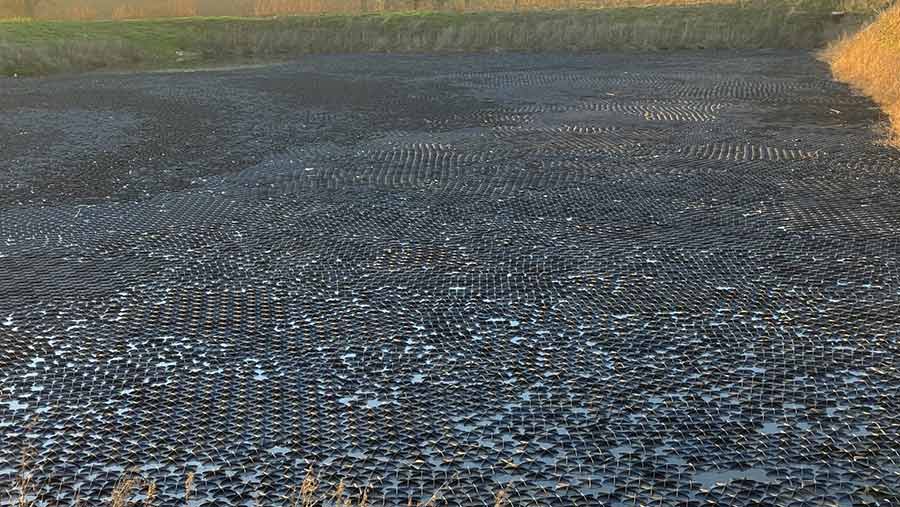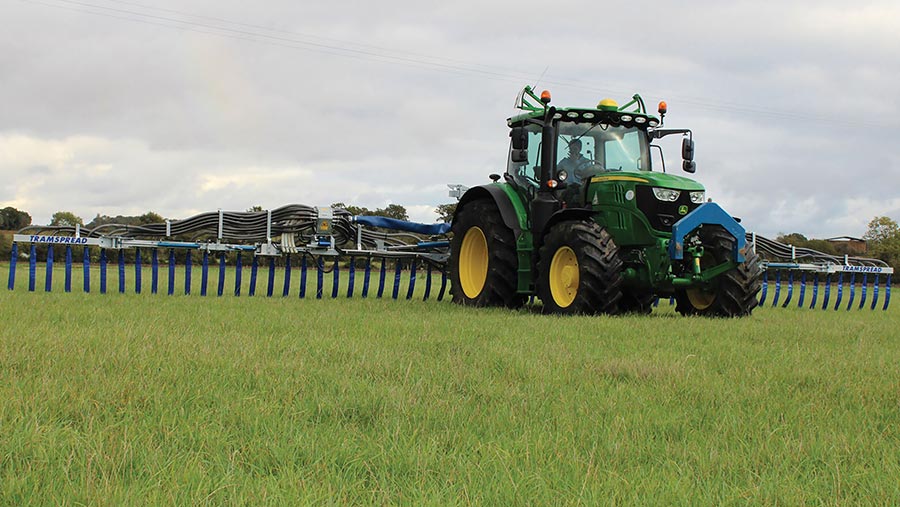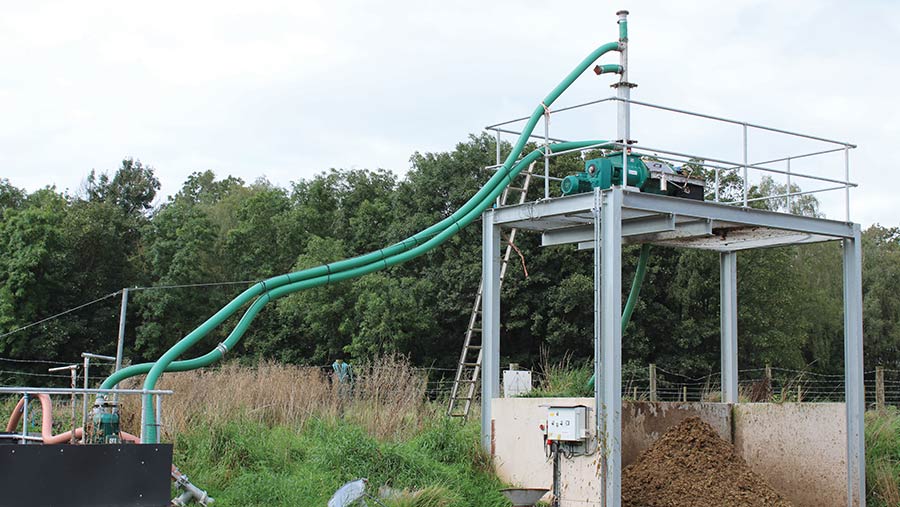What to consider ahead of new slurry regulations
 © Tramspread
© Tramspread The huge cost of managing slurry can be offset by improving its value as a fertiliser to reduce bought-in products.
But simply adding a grant-funded cover to existing slurry storage will not improve this asset.
See also: Labour to offer more slurry infrastructure cash if it wins power
“It isn’t just about the store and a cover, but the whole handling of slurry,” says John Tydeman of Tramspread.
“A more homogenised product that is easier to spread, creates less wear on equipment and is a cost-effective nutrient source is needed”, he adds.
This means, for many farms, an overhaul of the whole slurry storage, handling, testing and spreading system.
“Start looking after slurry and treat it as an asset. At the very least, make sure that [slurry] channels are not dumping grounds for rubbish such as silage wrap, netting or string.
“Make it a better product to start with and [take advantage] of significant environmental benefits as well as financial savings,” he says.
Sand bedding, rainwater and solids build-up all affect slurry handling, explains John.
Store covers have to be impermeable under the grant scheme, but the floating fabric used makes it hard to stir slurry.
Rainwater also collects on the surface and needs to be regularly pumped off.
The result is that solids build up and a thick slurry forms, which affects storage capacity, as well as being harder to pump. Whole slurry benefits from rain to make it easier to pump.
“But if you separate slurry and look after it right from the start, treating with an additive once a year to reduce the build-up of solids, you can [successfully] cover the store with an impermeable cover,” he says.
However, John says that sand is “a nightmare” for slurry handling and should not be put into a covered store.
“Use a sand lane to remove it, so you have a watery product that is easy to store.”
Separated liquor still benefits from stirring just before spreading, as some solid can “go gloopy in the bottom, though not enough to form a crust”, says John.
“In drier parts of the country, where more crust develops, stir more. It is best to over-stir it to start with and then back off: every two to three weeks, then leave it for six weeks to see how it is.”
Starting from scratch, a separation infrastructure and system will cost from £60,000 plus storage for the liquid, although it is possible to use an existing store or lagoon.

© Tramspread
Test the nutrient cycle
Analysing soil, slurry and silage is key to connecting the whole nutrient cycle and being able to fix problems, according to Bob Fabri, international product manager for Eurofins laboratories.
But relying on just one test result for management decision-making can give a false picture, he says.
“Phosphorus, for instance, is important to plant and cow health, but it is very immobile in soil, travelling only 2-4mm.
“The plant root needs to seek it out, unlike other elements such as chlorine, which can travel 40-50mm,” he says.
Phosphorous is used by young plants for early growth.
“As a rule of thumb, 75% of the requirement for P is taken up by the plant when the dry matter is 25%,” he explains.
Soil compaction affects plant uptake, as does interaction with other elements such as copper, iron, zinc and potassium.
Phosphorus also gets more bound to other elements when the soil is below pH 5.0 and above 7.0.

© Tramspread
As phosphorus inputs have fallen to meet environmental targets, Bob says vets in the Netherlands are now reporting health problems in dairy cows.
They initially appear as milk fever, yet turn out to be phosphorus deficiency. In one case of a 100-cow herd (milked through two robots and averaging 10,000 litres), the farmer ended up culling cows. Blood testing revealed the herd was phosphorus deficient.
“A cow needs 79g P/day; in his herd, they were getting 71g. Cows can release P from their bones, but they can’t restock this and so get more vulnerable. Older cows end up being culled,” says Bob.
By law, every tanker of slurry applied in the Netherlands has to be tested, and this farmer was also analysing his soil and silage.
“The farmer said he had high phosphorus in his soil, but poor levels in the slurry and silage. This was because it was bound to other elements and unavailable to the plant.
“We investigated and discovered that the farm had old sea clay soils that were sky-high in carbonate lime, at 9.2%, instead of the usual 2-3%.”
Every time the farmer applied his manure to grassland, the pH rose (going up to 7.2), exacerbating the problem.
Phosphorus became locked up, and because of the carbonate lime, adding more phosphorus would have been ineffective.
Instead, it was included in concentrates, and within two months, slurry tests showed that levels had almost doubled, says Bob.

© Tramspread
Enhance slurry value
To make the best use of slurry with a known nutrient value, Origin Fertilisers nutrition agronomist Toby Ward advises using the RB209 guide to tie test results and soil analysis together to create a nutrient management plan.
“Then look at how to bridge the ‘hunger gap’ for the crop,” he says.
By identifying the nutrient gap, Toby says it is possible to calculate the balance needed from what Origin calls its “prescription-grade” synthetic fertiliser.
The cost per tonne is not cheaper than conventional products, but cost per nutrient value is.
“This results in not overfeeding or wasting fertiliser,” he points out.

